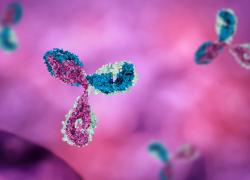
ASCO 2025 – BioNTech’s latest Claudin6 effort falls short
BNT142 looks lacklustre, but the company still sees promise in mRNA-encoded bispecifics.
BNT142 looks lacklustre, but the company still sees promise in mRNA-encoded bispecifics.

BioNTech, already being chased by rivals to its Claudin6 Car-T project BNT211, reported lacklustre efficacy with another Claudin6-targeting asset at ASCO on Saturday. BNT142, an mRNA-encoded T-cell engager, produced a confirmed overall response rate of just 5% among various Claudin6-positive solid tumours in a phase 1/2 trial, rising to 7% among a subset of 42 ovarian cancer patients.
Including unconfirmed responses gave a slightly better 12% ORR across tumour types, but this still falls short of results seen with BNT211 and Claudin6-targeting ADCs from TORL Biotherapeutics and Daiichi Sankyo at last year’s ESMO meeting.
Still, BioNTech’s chief medical officer, Özlem Türeci, told ApexOnco at ASCO that the data had validated the group’s mRNA-encoding approach. The company plans to continue developing this technology – and might even persevere with BNT142, she added.
“We’re looking deeper in the data right now, and we’ll decide,” she said. She declined to disclose other potential targets, but added: “This is a platform which could give rise to its own small pipeline of programmes.”
In the meantime, BioNTech is “going back and refining the manufacturing process” to support larger studies, although Türeci wouldn’t say how long this might take.
mRNA encoding
The technology is designed to spur patients to create their own therapeutics, in this case bispecific antibodies. Türeci contended that there were disadvantages to conventional T-cell engagers, including the fact that a new manufacturing process has to be established for each therapeutic.
Whereas with mRNA-encoded projects, “in principle you could put into the cassette any antibody you want. You don’t need to invest three years to fine tune the manufacturing for this one antibody.”
Another potential advantage of BioNTech’s approach is that, owing to continuous mRNA expression, this leads to a therapeutic with a longer half-life versus conventional bispecifics, negating the need for high dosing – something that has led to toxicity with T-cell engagers, she said.
Overall, Türeci believes that the study has shown proof of concept for the platform, with unexpectedly “robust” pharmacokinetic data.
But, in terms of overall response rates, BNT142 leaves much to be desired compared with other Claudin6-targeting agents.
Cross-trial comparison of Claudin-6-targeted projects
BNT142 | BNT211 | TORL-1-23 | DS-9606a | |
|---|---|---|---|---|
| Company | BioNTech | BioNTech | TORL Biotherapeutics | Daiichi Sankyo |
| Description | mRNA-encoded T-cell engager | Car-T | ADC | ADC |
| Study | Ph1/2 global trial | Ph1/2 OUS trial | Ph1 US trial | Ph1 global trial |
| Tumours | Claudin6+ve solid tumours (mostly ovarian) | Claudin6+ve testicular, ovarian & others | Ovarian & others (most Claudin6+ve) | Ovarian, germ cell & others (Claudin6 positivity not required) |
| Cutoff date | 1 Apr 2025 | 16 May 2024 | 16 Jul 2024 | 14 Jun 2024 |
| Confirmed ORR | 5% (3/61)* | 33% (21/64) | 33% (21/64) | 15% (4/26) |
| ≥Gr3 TRAEs | 25% | 67% | N/A | 6% |
| Fatal TRAE | 2% | 4% | N/A | 0% |
Note: *another 4 responses were unconfirmed. Source: ASCO 2025 & ESMO 2024.
Complicating the cross-trial comparison was the fact that not all of the trials required patients to be Claudin6-positive, and different definitions of positivity were used: the BNT142 study required 10% or more cells to be positive, while the BNT211 and TORL-1-23 trials used 50% and 30% cutoffs respectively.
Safety with BNT142 looked better than with BNT211, but two dose-limiting toxicities were still seen at higher doses of BNT142, and there was a fatal treatment-related case of cytokine release syndrome at a dose of 50µg/kg.
This story has been updated to include comments from BioNTech.
4102













